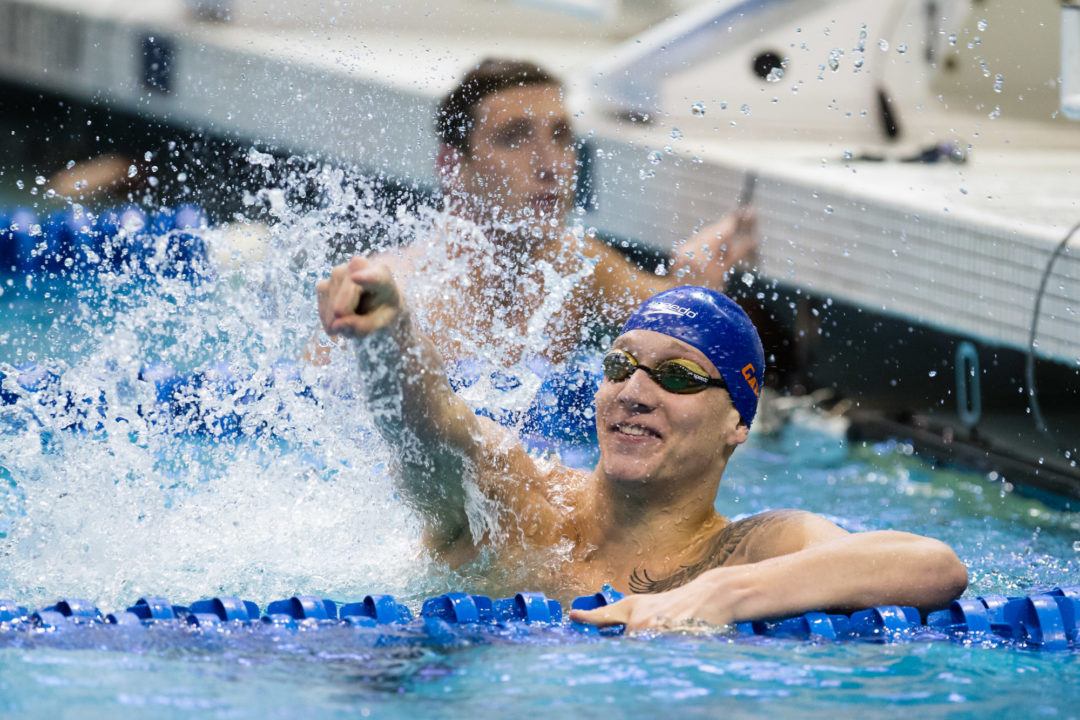As NCAA programs begin their all-important mid-year invite season this week, now is the perfect time to look at how fast swimmers will have to go to earn guaranteed and/or likely NCAA invites this winter.
Many programs give their athletes rest, fast suits and even shave-downs for these mid-season invites. The advantage is that it can allow some swimmers to solidify their NCAA bids early and keep them from having to pull a double taper for a conference meet in February (to qualify for NCAAs) and the NCAA meet in March.
The NCAA invite system is a bit complex. You can read our full primer on it here, but the gist is that an “A” cut will earn you an automatic bid. After that, the next-fastest swimmers in each event get invited until the total participant number (270 for men, 322 for women) is met.
Each year, the cut lines fall in roughly the same place on the psych sheets. Below, we’ve compiled the A cuts in each event, plus the 2017 invite time, or the slowest time that earned an NCAA invite in that event last year. Remember that as the NCAA gets faster each year, the invite times usually get faster as well. But an athlete significantly below these invite times should have a good shot at making NCAAs even if they don’t have an A cut – though an A cut is the only thing that guarantees an invite.
For relays, teams must hit a Qualifying Standard (QS) in any one relay to earn NCAA invites for that relay and any other relays that hit a Provisional Standard (PS).
Individual
| MEN | WOMEN | |||
| A Standard | 2017 Invite Time | Event | A Standard | 2017 Invite Time |
| 19.05 | 19.43 | 50 free | 21.8 | 22.23 |
| 42.11 | 42.76 | 100 free | 47.53 | 48.62 |
| 1:32.54 | 1:34.20 | 200 free | 1:43.30 | 1:45.44 |
| 4:12.49 | 4:16.67 | 500 free | 4:36.30 | 4:41.84 |
| 14:40.75 | 14:56.84 | 1650 free | 15:53.50 | 16:16.41 |
| 45.49 | 46.1 | 100 fly | 51.19 | 52.52 |
| 1:41.44 | 1:43.09 | 200 fly | 1:53.80 | 1:56.60 |
| 45.25 | 46.28 | 100 back | 51.16 | 52.65 |
| 1:39.66 | 1:41.74 | 200 back | 1:50.99 | 1:54.00 |
| 51.74 | 52.62 | 100 breast | 58.85 | 1:00.34 |
| 1:52.94 | 1:54.54 | 200 breast | 2:07.18 | 2:10:55 |
| 1:41.88 | 1:44.34 | 200 IM | 1:55.00 | 1:57.66 |
| 3:39.95 | 3:44.92 | 400 IM | 4:04.70 | 4:10.86 |
Relay
| MEN | WOMEN | |||
| Qualifying | Provisional | Event | Qualifying | Provisional |
| 1:17.62 | 1:18.35 | 200 free relay | 1:28.71 | 1:29.57 |
| 2:52.10 | 2:53.23 | 400 free relay | 3:15.43 | 3:16.93 |
| 6:20.05 | 6:23.58 | 800 free relay | 7:03.86 | 7:07.86 |
| 1:24.82 | 1:25.62 | 200 medley relay | 1:36.89 | 1:37.51 |
| 3:07.46 | 3:08.95 | 400 medley relay | 3:32.67 | 3:34.48 |

Nearly a 41 to make A cut in the 100 free…
Funny – when I saw that I thought, “42.1 looks kind of slow for an A cut”. Of course ten years ago Cielo was the only guy under 42.
Is this the year for back or fly that it takes a 45?
Must be the year for a happy medium where the A time for the 100 back is faster than the 100 fly, but the invite time for the 100 fly is faster than the invite time for the 100 back.
Those A standards are crazy and goes to show how far swimming has come so fast.
How you okay with this blatant sexism?!!??!???!? 52 more girls then boys?!?!?!?!?! lol jk but yeah way is there more girls then boys?
The numbers are based off the total number of swimmers in the NCAA. There are more female programs so there are more female swimmers overall, which is why more are invited.
Incorrect. The disparage in numbers is due to Title IX law which affects both scholarship and the number of NCAA invitees in swimming.
I think you guys are actually saying the same thing, in truth.
Either way it sucks. They took a bad situation for girls and turned it into a bad situation for boys. Completely unfair both ways. One of those unintended results that will be hard to correct because some will argue that any tampering with Title IX will be a detriment to women. Me thinks it can be done to satisfy both. But what do i know?
There are more girls than boys involved in swimming at every level…